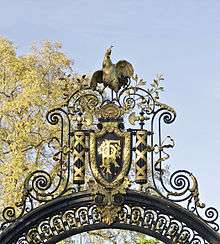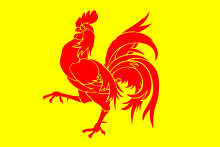Gallic rooster
The Gallic rooster (French: le coq gaulois, Gallic cock) is an unofficial national symbol of France as a nation, as opposed to Marianne representing France as a state, and its values: the Republic. The rooster is also the symbol of the Wallonia region and the French Community of Belgium.

France
During the times of Ancient Rome, Suetonius, in The Twelve Caesars, noticed that, in Latin, rooster (gallus) and Gauls (Gallus) were homonyms.[1] However, the association of the Gallic rooster as a national symbol is apocryphal, as the rooster was neither regarded as a national personification nor as a sacred animal by the Gauls in their mythology and because there was no "Gallic nation" at the time, but a loose confederation of Gallic nations instead. But a closer review within that religious scheme indicates that "Mercury" was often portrayed with the cockerel, a sacred animal among the Continental Celts.[2] Julius Caesar in De Bello Gallico identified some gods worshipped in Gaul by using the names of their nearest Roman god rather than their Gaulish name, with Caesar saying "Mercury" was the god most revered in Gaul.[3] The Irish god Lug identified as samildánach led to the widespread identification of Caesar's Mercury as Lugus and thus also to the sacred cockerel, the Gallic rooster, as an emblem of France.
Its association with France dates back from the Middle Ages and is due to the play on words in Latin between Gallus, meaning an inhabitant of Gaul, and gallus, meaning rooster, or cockerel. Its use, by the enemies of France, dates to this period, originally a pun to make fun of the French,[1] the association between the rooster and the Gauls/French was developed by the kings of France for the strong Christian symbol that the rooster represents: prior to being arrested, Jesus predicted that Peter would deny him three times before the rooster crowed on the following morning. At the rooster's crowing, Peter remembered Jesus's words. Its crowing at the dawning of each new morning made it a symbol of the daily victory of light over darkness and the triumph of good over evil. It is also an emblem of the Christian's attitude of watchfulness and readiness for the sudden return of Christ, the resurrection of the dead, and the final judgment of humankind. That is why, during the Renaissance, the rooster became a symbol of France as a Catholic state and became a popular Christian image on weather vanes, also known as weathercocks.
The popularity of the Gallic rooster as a national personification faded away until its resurgence during the French Revolution (1789). The republican historiography completely modified the traditional perception of the origins of France. Until then, the royal historiography dated the origins of France back to the baptism of Clovis I in 496, the "first Christian king of France". The republicans rejected this royalist and Christian origin of the country and trace the origins of France back to the ancient Gaul. Although purely apocryphal, the rooster became the personification of the early inhabitants of France, the Gauls.
The Gallic rooster, colloquially named Chantecler, had been a national emblem ever since, especially during the Third Republic. The rooster was featured on the reverse of French 20-franc gold pieces from 1899 to 1914. After World War I it was depicted on countless war memorials.
Today, it is often used as a national mascot, particularly in sporting events such as football (soccer) and rugby. The 1998 FIFA World Cup, hosted by France, adopted an anthropomorphic rooster named Footix as its mascot. Two decades later, the 2019 FIFA Women's World Cup, also hosted by France, featured a young anthropomorphic female chicken known as ettie (officially in lower case) as its mascot, with ettie being depicted as the daughter of Footix. The France national rugby league team are known as the Chanteclairs, referring to the cockerel's song.
The popularity of the symbol extends into business. Le Coq Sportif ("The athletic rooster"), is a French manufacturer of sports equipment using a stylized rooster and the colors of the French tricolour as its logo. Moreover, it is the logo of Pathé, a French-born, now international company of film production and distribution.
Another heraldic animal officially used by the French nation was the French Imperial Eagle, symbol of the First and Second French Empire under Napoleon I and Napoleon III.
Wallonia

In 1913, the Gallic rooster was adopted as the symbol of Walloon movement. It represents a "bold rooster" (coq hardi), raising its claws, instead of the "crowing rooster" that is traditionally depicted in France. This symbol, also known as the Walloon rooster, was officially adopted as the symbol of Wallonia (in 1998) and the French Community of Belgium (in 1991).
Cocorico
In France and Wallonia, the French onomatopoeia for the rooster crowing sound, "cocorico" (cock-a-doodle-doo), is sometimes used as an expression of national pride. [4]
See also
References
- Collignon, Alain (6 April 2017). "Drapeau wallon" [Walloon flag] (in French). Wallonia: Institut Destrée [The Destree Institute]. Retrieved 13 March 2018.
- Ellis, Peter Berresford (23 June 1994). Dictionary of Celtic Mythology. New York: Oxford University Press. ISBN 978-0195089615.
- Caesar, Julius (53 BC). . Commentarii de Bello Gallico [Commentaries on the Gallic War]. Book 6. Translated from Latin by William Alexander McDevitte and W. S. Bohn (1869) – via Wikisource. Check date values in:
|year=(help) - "cocorico — Wiktionnaire". fr.wiktionary.org.
External links
![]()
- Embassy of France in the United States - additional information
- French Prime Minister's office - additional information
- Images of Footix, the cockerel mascot of the 1998 FIFA World Cup.
- France plucks its bird from peril, from BBC. A plan to preserve the genetic heritage of the French cockerel.